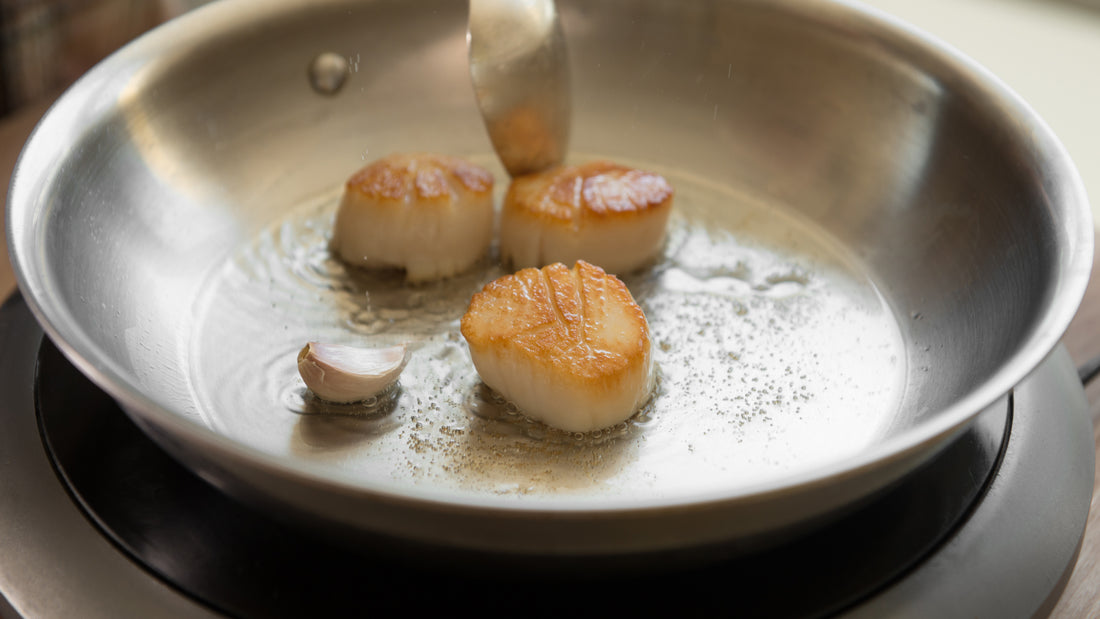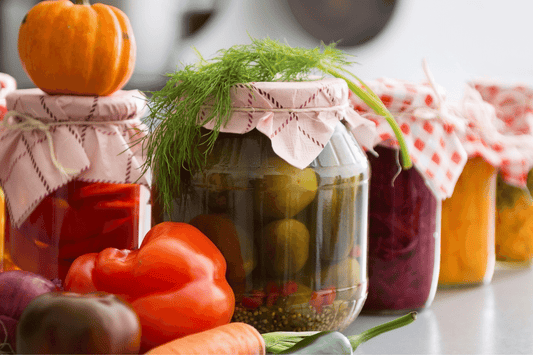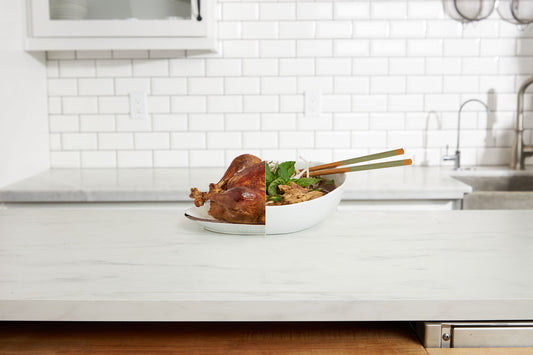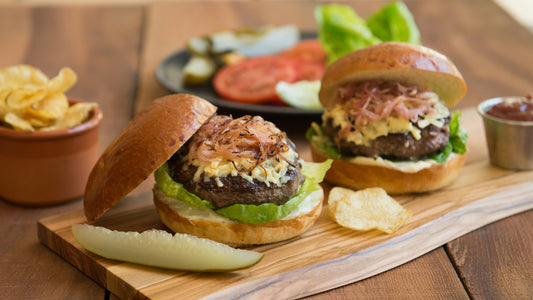By: Julian Weisner, Chef and Culinary Scientist
The 500+ video guided recipes in the Cue app are never complete. Even after hours of hard work and development, when we launch a new recipe we wait on the edge of our seat for our users to tell us what they think. When we receive feedback on something we miss, we don’t just add an update at the end, we often go back to the drawing board to retune the recipe from scratch. Over the years this has guided both what recipes we introduce and what improvements we make.
Recently we’ve heard from users when searing steak or fish in our 11" Pan, ‘that while the results are spectacular, the process is a little too 'splattery'. We’ve seen your patchwork of towels and anti-splatter contraptions and, while we love the ingenuity, we also know that there is a better solution. So our team of accomplished chefs have reformulated, re-cut videos, and revamped your favorite recipes to guarantee a new level of success, without the mess!

And today we are happy to introduce an improvement we’ve had in the works for over a year. We have now significantly reduced the splatter in over 50 of our recipes. For the last 14 months we’ve been working in the test kitchen to address excessive splatter in many of our recipes. We’ve already released updates to favorites like Pan Seared New York Strip Steak and Shrimp Scampi. We wanted you to know that if you’ve seen a difference recently, you’re not crazy, something has changed, and it’s the cleanliness of your countertop.
How Did We Do It?
Good question, the short answer is, we removed a lot of oil from our recipes. Less oil in the pan to begin with means less splatter can leave the pan while we’re cooking. Simple enough, but you know there’s more to it than that. We’re going to tell you everything we learned while reducing the splatter, so you can adjust your favorite recipes too!
Oil’s Effects on Cooking Time
Roughly speaking: more oil means less cooking time. For example frying a chicken breast (not breaded) in an inch of oil, like in a cast iron skillet, will take a lot less time than searing a chicken breast in a mostly empty pan.
With an inch of oil the chicken breast is cooking from many different directions. Heat closes in on the center fast completing the cooking process in as little as 15 to 20 minutes. Compared to the empty pan, the chicken breast is only cooking from one side. It takes much longer for the heat to reach the center; sometimes as much as 30 minutes or more. This is a big reason we love basting. Check out "The Art of Basting" to learn more.
While those examples are very, very different from one another, we were able to see similar effects within our small recipe changes too. We found that changing the oil volume from 2 tablespoons to 2 teaspoons (a ⅔ reduction) was enough to affect the cook time of our chicken breast. What would be a perfectly juicy chicken breast with 2 tablespoons, would be consistently undercooked when we used just 2 teaspoons. Obviously we can fix undercooking by adding more time, but sooner or later we start looking at 45 minutes to cook a chicken breast. We’re here to help you cook good food and it’s not supposed to take all night! So there’s a happy middle ground, less oil to reduce the mess, but enough that the cook time is reasonable. With our recipe for pan seared Boneless Skinless Chicken Breast we landed on 1 tablespoon without needing to adjust the temperature.

Oil’s Effects on Searing & Sticking
What’s the skinny on the sear? When we are preheating, both our pan and our oil are part of our 'battery' so to speak. We charge up our battery to sear our food, and help it release. The 'battery' is the heat energy stored that is used during the first few seconds of cooking to offset the cold shock of the food.
Let’s say we are going to sear some salmon. A bigger battery will equate to a smaller temperature drop right after we add them to the pan. The right sized battery will help us quickly boil away excess water from our food and begin to crisp it. This process ensures the food releases from the surface of the pan. For a delicious and fun example of this try our Crispy Skin Salmon.

One of the ways we change the size or 'energy' of our battery is by adjusting the oil volume. When we remove oil to reduce splatter we are shrinking our battery. To offset this, we need to add energy somewhere else. We can do this by adjusting our starting temperature. Increasing the initial temperature of our recipe will increase the energy of our battery.
For Pan Seared Scallops, for instance, we increased our initial cooking temperature from 435°F to 450°, while reducing the oil from 2 tablespoons to 1 tablespoon. These two changes cancel each other out and we were able to keep our scallops stick free, while simultaneously reducing the mess. Try out the updated recipe for yourself and share the results on our Facebook Community.
Oil’s Effects on Cook Uniformity
Let’s get basted! Oil also functions as the medium to help move the heat from the pan to our food. It increases the surface area of contact and helps develop that delicious crust or sear. When we reduce the oil volume, we are also reducing the area of contact.
Take a minute to imagine a delicious fluffy fried doughnut, don’t take too long, there are two golden brown sides with a small pale band where they meet in the middle. That band indicates where the oil did not touch the doughnut. We can see the same pattern on a chicken breast or a pork chop.
As we reduce the oil volume we also reduce how much the surface of our food is in direct contact with high heat. In order to balance this we need to pull out one of our favorite restaurant techniques: basting.

For all of the recipes that we’ve adjusted the oil volume to reduce splatter, we’ve now added an extra ingredient for basting- butter or in some cases more oil! You’ll now find that many of our recipes recommend adding additional oil or butter at the end of the cook session along with the aromatics. This will help you even out the cooking throughout your food, and it will help enrobe your food with those delicious baste-y flavors. Luckily you, our users, are already master basters, so the fix is in your hand, the spoon.
Is That All?
Never! We couldn’t have made these recipe improvements without our users helping us along the way. We’ve asked you for help, and you’ve answered. When you ask us for help, we love to answer the call. These 50 recipes are as much the HSC team helping our users succeed as it is our users helping us improve. As we explore in Finding the Best Recipes Online every Hestan Cue recipe is alive!
We love to see what you are cooking on Cue. Look for more inspiration and share your recipes or ask our Chefs for advice in our Facebook community.
For more recipe inspiration check out the Cue app, where you can discover over 500 chef-crafted recipes, all with step-by-step video guidance from prep to plating. Download the Hestan Cue app for iOS and Android and learn more about precision cooking with Cue, and all the things you can do!




